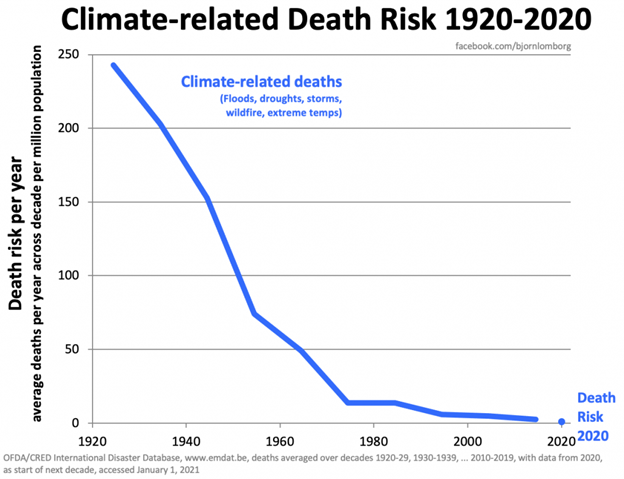National Public Radio (NPR) recently published a largely pictorial article, titled “Meet 5 women documenting the effects of climate change around the world,” composed of photographs taken by women that supposedly, “highlight climate change.” In reality, what these women covered in dramatic photographs are the impacts of civil strife, government corruption, and natural weather events, on communities, not harms human caused climate change.
The article suggests that extreme weather is worsening globally, impacting different communities in different tragic ways. Even the International Panel on Climate Change disagrees with this fundamental point, and a comprehensive analysis of the IPCC data on extreme weather by the Global Warming Policy Foundation’s Ralph Alexander, Ph.D., concludes that “Careful examination of the actual data reveals that if there is any trend in weather extremes, it is downward rather than upward.”
Data show that climate related deaths are way down worldwide in recent decades compared to the past, shown in the image below.

One of the highlighted regions, Somalia, is described in the NPR piece as “one of the places that has contributed the least to global carbon dioxide emissions, and yet its environment is among the most severely impacted, in irreversible ways.”
Somalia suffers from severe flooding during their monsoon season, called “Gu rains.” These periods of flooding are essential to agriculture in the region, as it is otherwise mostly arid. Like in California, fluctuations between drought and monsoon have historically been regular part of Somalia’s climate, possibly due to an oscillating system in the Indian Ocean called the Indian Ocean Dipole which is similar to the Pacific’s El Niño. As population centers in Somalia grow into low-lying areas, previously used for monsoon dependent agriculture, they are more susceptible to encountering floods resulting from periodic, seasonal Gu rains.
Somalia is plagued not so much by climate change but rather by violence and government corruption, leading to destroyed or delayed vital infrastructure and poorly managed aid resources. Civil war has been raging in Somalia since 1991. This was covered by NPR in the past in this article, describing the once-beautiful city of Mogadishu which is now in chaos and ruin.
The United Nations says that places like South Sudan also suffer famine primarily because of human violence and war in the region, stating in a BBC report that “The main cause of the famine is conflict.”
East Africa recently suffered from locust swarms, as shown in the NPR photos, which hatched out in largely unpopulated parts of the region. As described in this report, due to poor coordination between nations and green-agenda driven lack of pesticides, locusts swarmed and devoured unprotected crops before they could be sprayed and killed. Locusts are not unprecedented in Africa, and are certainly not due to climate change. In fact, their hatch rates may be tied to that same Indian Ocean Dipole event that serves as a driver for the Gu rains in Somalia.
The NPR piece also showcases West African coasts as suffering from coastal erosion and flooding, which they say is caused by accelerating sea level rise. As covered in Climate Realism here, and in this Heartland Institute analysis here, it is clear that coastlines grow and shrink as a result of natural forces like tectonics or storms, and also due to human development impacting the structural integrity of coastlines. No human-caused warming required.
Regions with major river deltas are likely more susceptible to land subsidence and sea level rise than others, as this study shows, such as the Volta River Delta of Ghana. Major land subsidence and erosion began to occur in Ghana after large dams were built upstream which reduced sediment flow into the delta.
The NPR article also implies Hurricane Maria was a creation of climate change. Hurricanes are entirely natural events and no single hurricane can be attributed to climate change. What the data does show, however, is hurricanes have not been increasing in number or severity as the planet modestly warms, as discussed in these Climate Realism articles here, here, and here.
Taking pictures of people in distress after severe weather events, then attributing their suffering to man-made climate change is uninformed at best, and cruel exploitation at worst. The impact of natural disasters globally can be reduced in developing countries as they have in the developed world through human innovation, adaptation, and economic growth. The harms resulting from war and government corruption have nothing to do with climate change and won’t be solved by cutting carbon dioxide emissions. Directing focus away from the real causes of human struggles in at-risk regions of the world serves no one but the journalists in pursuit of accolades from the like-minded mainstream media for pursuing the progressive political cause of expanding government control to fight supposed climate change.


















The chart is deceptive because the large decline of deaths can not be attributed to the small change in the climate in that 100 year period. Much of the decline is better warnings of extreme weather on the way, and better medical care. The chart also misses a key life saver for heart patients — winters not as cold as 50 years ago in the Northern Hemisphere.
Better charts would show long term trends of hurricanes, tornadoes, heat waves and droughts. All in long term flat trends or declines, when you ignore those storms (non-land falling hurricanes and minor tornadoes) likely to be missed before the satellite age.
Global wildfire indexes are also down since 2000 but wildfires are only about 10% natural, so at least 90% of them (probably closer to 100%) can’t be blamed on a slightly rising global average temperature and rising rainfall.
Consider California:
It gets dry enough there for wildfires every year.
A +1 C. degree warmer temperature can’t make dry foliage any drier, when it is already dead and dry! But the lack of forest management can sure promote more acres burned by the wildfires that do happen.